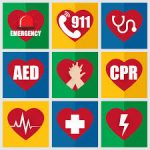
In workplaces, cardiac arrest occurs due to trauma or sudden death. Being trained in cardiopulmonary resuscitation (CPR) and first aid can mean the difference between life and death either from a co-worker, a loved one or an unknown person whom you have decided to help.
In the Argentine Republic according to Res. 905/15, the labor medicine Service of the company trains each of the employees. It must do so with the occupational hygiene and safety service and with the other management sectors of the company, the institution or the foundation. It is clear that workers must have security elements for specific activities and know how to operate them. The truth is that the chances of an employee suffering a decompensation implies that he requires immediate assistance, being a reality more and more frequent in a stressed sedentary and overweight.
In case of emergency, an ambulance can take (depending on the location of origin) between 10 to 12 minutes in immediate response, but a person who enters cardio- respiratory arrest, in just 4 minutes begins to suffer brain damage and 8 to 10 minutes, brain death. Obviously, it is impossible for them to arrive on time.
Knowing the protocol of emergencies and CPR, allows the victim to continue with life until the arrival of the ambulance (even if he is unconscious); CPR supplants the lack of oxygen and circulation that the victim requires to be in cardio-respiratory arrest.
Steps to perform a CPR:
- Knowing how to recognize a cardiorespiratory arrest
When a person falls to the ground and does not respond, does not breathe or has no pulse, we must initiate a series of steps to verify if the victim is in cardiorespiratory arrest
- Check conscience
If the victim is conscious we will leave the person in the position in which we have found her and we will call emergency.
If there is no response, we will place the victim lying on his back on the floor and open the airway (one hand on the forehead backwards and the other under the chin raising the jaw up and forward)
- Check the breath
We control if there are chest movements, we listen and we make noise when we breathe or we notice the breath with the cheek or the hand.
If the person breathes normally, we will continue to reassess the victim until emergency services arrive.
In case the person does not breathe, start with chest compressions.
- How to start with chest compression?
It is essential that the blood continues to flow through the organs and we will achieve this with compressions.
We kneel next to the victim.
We place the heel of one hand in the center of the victim’s chest.
We place the heel of the other hand on the first one and we intertwine the fingers.
With a rate of 100 to 200 compressions per minute, we will do 30.
- Rescue insufflations
After 30 compressions we will perform 2 rescue breaths. We have to see how the chest is inflated to assess what we are doing correctly.
- We return to the compressions
We will perform 30 more compressions and we will do 2 rescue breaths until the victim breathes normally or the emergency services arrives.









